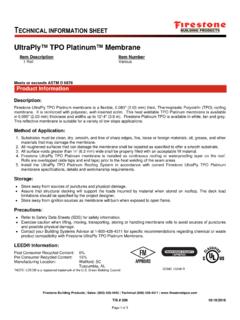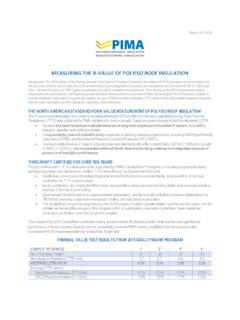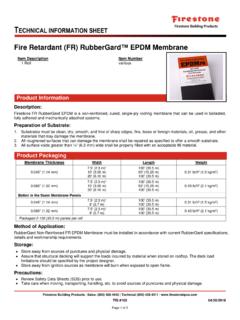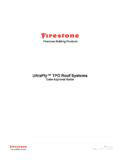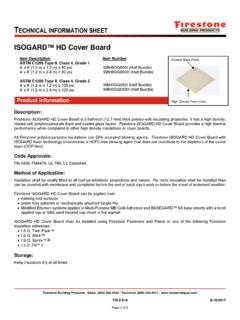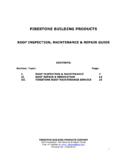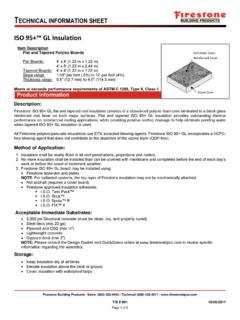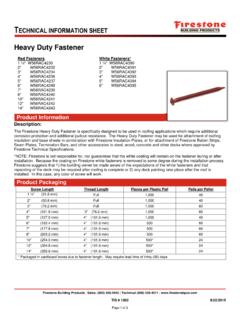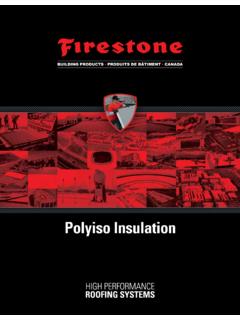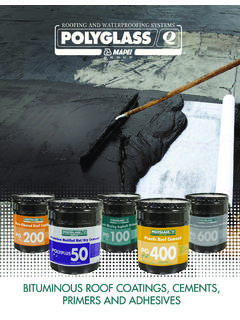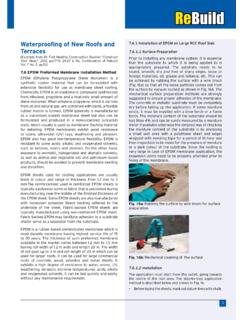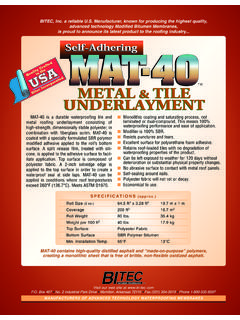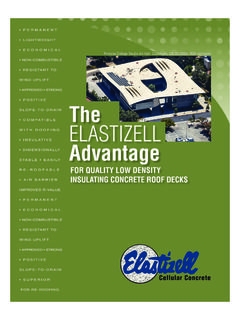Transcription of White Paper x A Durable Roofing Membrane That has Come …
1 XxA Durable Roofing Membrane that has Come of AgeTPO: Getting Better with AgeWhite PaperFirestone building Products n Nobody Covers You BetterTMPO has grown up. By any criteria, TPO is no longer the new kid on the block, when it comes to commercial/industrial Roofing . In fact, TPO (Thermoplastic Polyolefin) continues to be the fastest growing commercial Roofing Membrane on the market today, having grown to over 40% of the installed sq ft in the in the past seven years. Industry reports show that nearly billion square feet of TPO was installed in 2013. Its growth and market acceptance continue to outpace the overall commercial Roofing market. TPO is clearly leading the trend to White , reflective, energy efficient, heat welded single ply Roofing systems. While TPO can now be considered a mature product , it didn t get there without growing pains. TPO Roofing membranes were first used in Europe in the 1980s.
2 In 1992 TPO was introduced to the US. Some manufacturers with little or no experience were attracted to the new TPO market. In its infancy, the TPO industry did not have the strict standards that it has today. In fact, the ASTM standard for TPO is now the most stringent of any single ply Roofing material (see chart below).Initially, some manufacturers had performance issues resulting in material failures. Formulation trial and error was not uncommon. This left some to question the durability of TPO. Today those issues have largely been eliminated. Many of the early manufacturers are either out of the business or have refined their original formulas and manufacturing process to solve their initial performance problems. The evolution of TPO was very similar to other commercial Roofing materials like EPDM and PVC where trial and error has eventually resulted in quality materials over time.
3 It only took 8 years after its initial introduction for TPO to make serious inroads in the US. One growth factor was the entry into the TPO market by well established companies, such as firestone building Products, with significant experience in polymer engineering and manufacturing of rubber products. The companies that remained along with other key stakeholders have helped drive today s exacting performance specifications. Professional standards have brought a welcomed and necessary degree of credibility to the TPO manufacturing community. Not to mention peace of mind to architects, contractors and building is a member of the thermoplastic single-ply Membrane family, which includes PVC. TPO is a polypropylene based plastic and ethylene/propylene rubber. The plastic and rubber blend enables TPO membranes to be Durable and remain flexible even in low is a common misperception that one TPO is the same as another.
4 This is not true. The major TPO producers each have their own formula/chemistry, product design and manufacturing process. It s important to understand that every manufacturer makes their own version of : Getting Better with Age 1 TTPO (old ASTM)TPO (new ASTM)EPDMPVCKEEASTM StandardD6878D6878D4637D4434D6754 Xenon ArcTemperature800 C800 C800 C630 C630 CHours @ W/m28,0008,0004,0005,0005,000 Oven AgingTemperature1160 C1160 C1160 C800 C800 CDays28224285656 High-quality TPO starts with good chemistry. Good chemistry is essential to engineering the right polymer. This is a critical consideration because the polymer is the backbone of the product . It is the base that allows all the other elements that go into the TPO formula to work together for the desired results. Technically speaking, the polymer is crucial if the UV stabilizers, fire retardants, titanium dioxide, antioxidants and heat stabilizers are to do their jobs.
5 TPO like all polymers is subject to degradation by UV and heat. This problem is mitigated through the use of stabilizers. Stabilizers slow polymer breakdown. It too needs to be compatible and work with all the other formulation components. Incompatibility can lead to premature degradation. Finding the correct combination of raw materials and a formulation, enabled by the right polymer is what good chemistry is all about. Perhaps this challenge is one reason why only a handful of companies today have the resources to manufacture s acceptance by the commercial Roofing marketplace is really no mystery. Once the performance issues were resolved, building owners, architects and contractors could objectively analyze the many benefits of TPO. TPO single-ply Roofing membranes provide exceptional resistance to ozone, ultraviolet rays and some chemical exposure. Achieving these performance characteristics are the result of the individual ingredients that go into the TPO formulation.
6 Because TPO is a thermoplastic it can be heat welded. This creates a monolithic roof while providing strength and light stabilizers are critical in that they provide weathering resistance and long-term strength. Fire retardants like magnesium hydroxide (non-halogenated) provide TPO with fire resistance without negatively affecting the UV stabilization package or harming the dioxide pigments determine the color of the Membrane and help provide increased whiteness and reflectivity. Heat stabilizers help resist heat degradation from the manufacturing process and after (polyvinyl chloride) is another member of the thermoplastic single-ply Membrane family. At first glance it is easy to see the similarities of both products. TPO and PVC are thermoplastic materials. Being heat weldable is another important shared characteristic. Heat welds provide a monolithic seam that prevents water intrusion.
7 Both are considered cool as a result of their White color which makes them reflective and resistant to the sun s heat and ultraviolet rays. Buildings with reflective roofs can stay cooler inside and save on air conditioning TPO starts with good chemistry. Good chemistry is essential to engineering the right : Getting Better with AgeFirestone building Products n Nobody Covers You BetterTMTPO: Getting Better with Age 2 The installation processes for TPO and PVC are nearly identical. Both require the same type of attachment materials, tools, procedures and skills. They can be mechanically attached or fully adhered. Both membranes are resistant to chemicals, grease and oil (to varying degrees). They are puncture resistant and can be easily repaired. Both are flexible and designed to conform to the movement of the the surface, it could appear that these two thermoplastic family members are very much alike.
8 However, there are major differences. It s in the chemistry where the similarities end. So while TPO and PVC are in the same thermoplastic family, they are chemically unrelated. TPO, is a naturally flexible polymer based material and does not require additives to achieve its flexibility. The TPO White reflective Membrane meets criteria of LEED , ENERGYSTAR , and other environmental programs. No roof lasts forever and one of the major environmental advantages of TPO is that it can be easily recycled with other plastics. The recyclable nature of TPO is a primary consideration for companies committed to the stewardship of our shared planet. Most people think of PVC as the hard plastic piping they find at the hardware store. This solid, non-flexible state of PVC creates the most significant difference between TPO and PVC. As a result of its normal hard solid state, PVC, unlike TPO, requires the addition of the aforementioned chemical plasticizers to achieve the pliability necessary to function as a Roofing Membrane .
9 Plasticizers are an artificial way to give PVC the flexibility that TPO has naturally with no chemical alteration. This is a negative characteristic of PVC because plasticizers can break down. Plasticizers attract mold or microbes. The microbes eat the plasticizer and tend to attach themselves to the roof, thanks to the food supply. Not only are microbes unwelcome dinner guests, they turn the PVC roof a darker color and reduce the reflective quality that is so important to energy since the plasticizers are required to make PVC flexible, the eventual loss of plasticizer results in a more brittle roof as the PVC reverts back to its original hard state. The roof can shrink and become more susceptible to hail damage and more difficult to heat weld while making repairs. This is a major difference between TPO which is naturally on Roofing systems are frequently made based on the specifications and physical characteristics of the roof.
10 The question is how long will those physical characteristics last?As the industry has matured, numerous studies and tests have been conducted to answer that question. One of the most recent and comprehensive studies of thermoplastic membranes, including TPO and PVC, was published in the May/June 2010 issue of RCI Interface Magazine. firestone building Products n Nobody Covers You BetterTMTPO: Getting Better with Age 3 firestone building Products n Nobody Covers You BetterTMTPO: Getting Better with Age 4 Testing was performed and reported by independent consulting firm, Jim D. Koontz & Associates in conjunction with Target Corporation, a national retailer that uses PVC Roofing on its own consultant tested 11 single-ply membranes 5 TPO and 6 PVC from 7 different manufacturers. Testing was for long-term exposure to UV over 18 months. Results found that , On average, the TPO membranes have a greater propensity for retaining physical properties when compared to PVC, KEE, and EV membranes.

